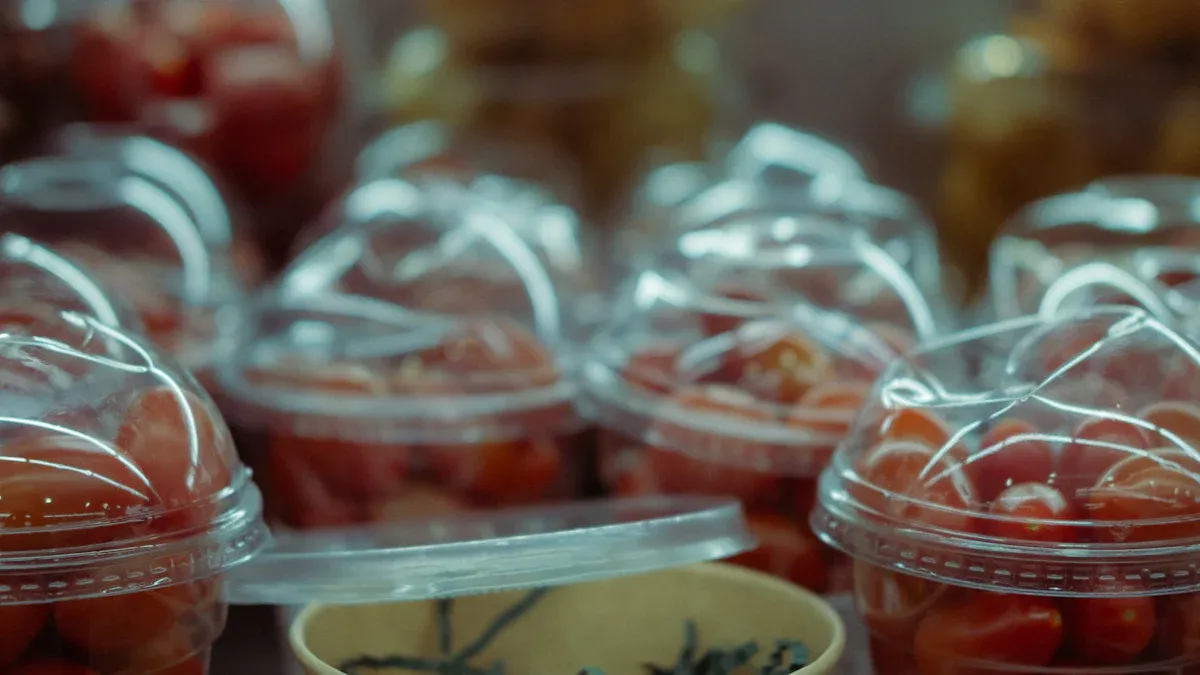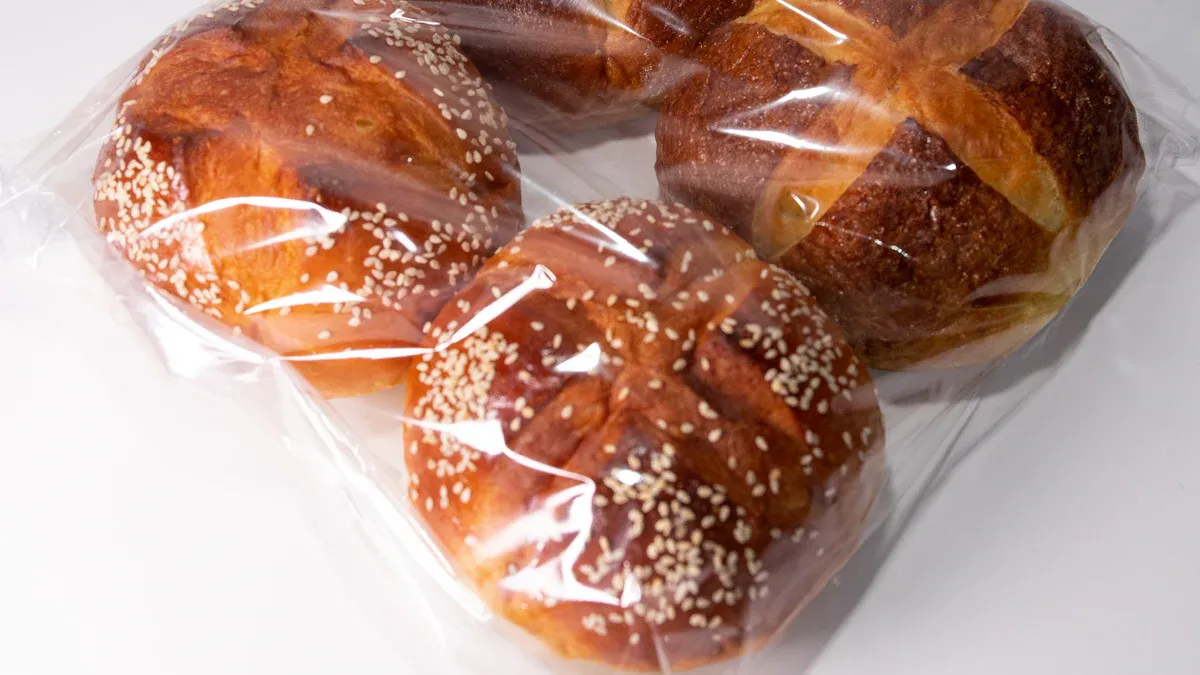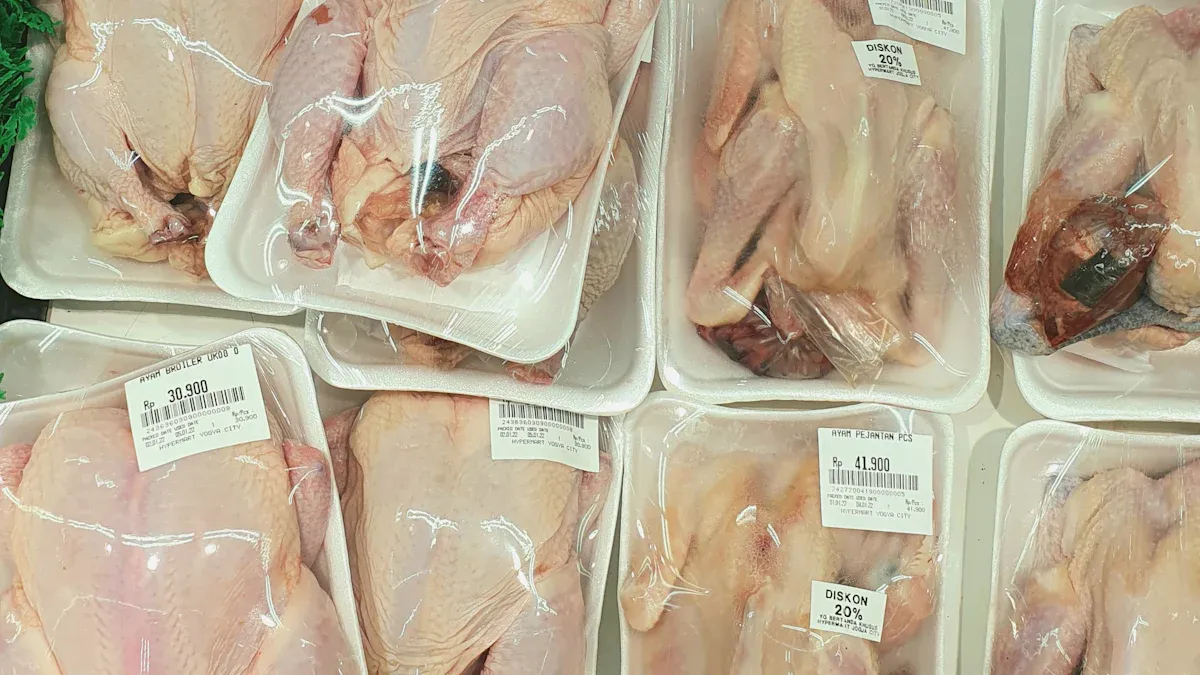
適切な冷凍食品包装材料を選択することは非常に重要です. 彼らは食べ物を安全に保ち、それが新鮮で美味しいままでいるのを助けます. これらの材料は、温度変化や細菌から冷凍食品を保護します. 環境に優しいパッケージも人気が高まっています. 人々は地球にとってより良いオプションを望んでいます. 新しいデザイン, 再生可能なバッグのように, 食べ物とお金を節約するのを手伝ってください. 適切な冷凍食品包装材料を選ぶと、食品の品質が向上し、環境を助けることができます.
キーテイクアウト
良い冷凍食品パッケージを選ぶことは、食べ物を新鮮で清潔に保つのに役立ちます.
プラスチックは安くて曲げやすいです, しかし、それはあまりリサイクルされていないので環境に害を及ぼします.
ガラスは惑星に適していて、食べ物を新鮮に保ちます, しかし、それは簡単に壊れ、移動するのが重いです.
生分解性材料は地球を助けます しかし、通常のプラスチックほどタフではありません.
食べ物の種類について考えてください, 料金, パッケージを選択するときの環境.
冷凍食品包装材料

プラスチック
プラスチックはとても人気があります 冷凍食品包装用の材料. そうです 軽量, 強い, そして手頃な価格. バッグとして見つけることができます, ラップ, またはコンテナ. プラスチックシールは簡単です, 食物を細菌から新鮮で安全に保つ. 水分をブロックします, グリース, とオイル, 冷凍食品に最適です. また、寒い気温でも柔軟性を維持します, あなたの食べ物を保護します.
さまざまなプラスチックにはユニークな用途があります. 例えば:
プラスチックの種類 | 特徴 | 用途 |
|---|---|---|
強い障壁, 耐久性のある | 冷凍食品包装に共通 | |
ポリプロピレン (PP) | 耐熱性, 曲げ可能 | ラップやフィルムで使用されます |
ポリ塩化ビニル (PVC) | よくシールします | しつこくラップにあります |
ポリエチレンテレフタレート (ペット) | 軽量, 頑丈 | 食べ物を新鮮に保つのに役立ちます |
しかし、プラスチックには環境問題があります. 多くのプラスチックは自然に壊れません. 不注意に捨てられた場合, 彼らは自然を傷つける可能性があります. リサイクル可能なプラスチックの方が優れています, しかし、リサイクル率は多くの場所でまだ低いです.
ガラス
グラスは、冷凍食品包装に高品質の選択肢です. 食べ物とは反応しません, フレーバーを新鮮に保ちます. ガラスは水分もブロックします, 食べ物が台無しになるのを止める. プラスチックとは異なり, ガラスは、品質を失うことなく永遠にリサイクルできます, 環境に優しいものにします.
ガラス包装の利点 | ガラス包装の欠点 |
|---|---|
食べ物とは反応しません | 簡単に休憩します |
水分をブロックします | 輸送が難しい |
食べ物を新鮮に保ちます | ストレージのためにかさばる |
ガラスにもいくつかの問題があります. 壊れる可能性があります, 安全ではありません. ガラスの移動と保管は、重くてスペースを占有するので硬いです. また, ほんのりです 33% ガラス廃棄物がリサイクルされます, グリーンの利点を制限します.
金属
金属は、もう1つの重要な冷凍食品包装材料です. それは強いです, 長持ちする, そして、食物を細菌から安全に保ちます. 金属缶には、食物が容器と反応するのを止めるための特別なコーティングがしばしばあります. また、これらのコーティングは、長期使用のために缶を頑丈にします.
金属は特定の冷凍食品に適しています. 例えば, 酸化亜鉛コーティングは、缶詰の食物が色を失うのを止めます. しかし、いくつかの食べ物, 硫黄が豊富な野菜のように, 金属を錆びさせる可能性があります. 適切な金属とコーティングを選ぶことが食品の安全の鍵です.
ヒント: 最良の結果を得るには、食品の種類と保管のニーズに基づいて金属包装を選択してください.
紙と段ボール
紙と段ボールは、冷凍食品包装に一般的です. 彼らです 軽量 リサイクル可能, 使いやすくします. これらの材料は、多くの場合、箱に形作られます, ラップ, またはカートン. 冷凍ピザ, 野菜, そして、デザートは通常それらに詰め込まれています.
紙と段ボールの大きな利点は、彼らの環境にやさしいことです. それらをリサイクルすると作成されます それらを燃やすよりも無駄が少ない, 有害な化学物質を放出します. 紙のある埋め立て地は作られます 10% 焼却よりも無駄が少ない. しかし、埋め立て地は依然として毒素を土壌に漏らします. リサイクルは、有毒な副産物を避けるため、最良の選択肢です.
紙と段ボールにはいくつかの欠点があります. 彼らは湿気に抵抗しません, したがって、凝縮は彼らを水浸しにすることができます. 製造業者はこれを修正するためにコーティングを追加します, しかし、コーティングはリサイクルを難しくすることができます. また, 紙と段ボールは、長い保管のためにプラスチックや金属だけでなく、食品を保護しません.
ヒント: より良い持続可能性のために、コーティングが少ないリサイクル紙または段ボールを選択してください.
生分解性および複合材料
生分解性および複合材料は、環境に優しいパッケージングの選択肢です. 彼らは自然に分解します, 廃棄物と汚染の切断. バイオポリマーベースのパッケージングは、海洋を保護し、二酸化炭素排出量を下げることで惑星を支援します.
いくつかの生分解性フィルム, セルロースのように, 土で壊れ始めます 8 日. その他, アルギン酸フィルムのように, その後、堆肥で完全に分解します 14 日. 澱粉ベースのフィルムは、海水に溶け込むことさえできます 42 日. これらの機能により、環境の危害を減らすのに最適です.
しかし、生分解性材料にはいくつかの問題があります. それらはプラスチックほど強くも耐えられません. それらを作ることもより多くの費用がかかります, バイヤーの価格を引き上げるかもしれません.
🌍 知っていましたか? 食品包装は補います 9% 海洋プラスチック廃棄物の. 生分解性の材料に切り替えると、海洋生命を救うことができます.
各資料の詳細な長所と短所
プラスチック
プラスチックは、冷凍食品包装には一般的な選択肢です. そうです 安い, 使いやすい, ラップがあります, バッグ, またはコンテナ. プラスチックは、空気や水分から食物を保護します. 軽いです, したがって、持ち運びや移動が簡単です. また、寒い気温で壊れることなく曲がります.
長所:
費用対効果: プラスチックは他の材料よりも低くなります. これにより、企業や買い物客にとって手頃な価格になります.
耐久性があり柔軟です: それは凍結温度で強いままであり、食物を安全に保ちます.
バリアプロパティ: 特別なプラスチック層は、空気と水分をブロックします. これにより、冷凍庫の燃焼が停止します.
利便性: 多くのプラスチックパッケージを再封できます. これは、食べ物を簡単に保管して再利用するのに役立ちます.
短所:
環境問題: ほとんどのプラスチックは自然に壊れません. これは汚染と無駄を引き起こします. リサイクル率は多くの分野でまだ低いです.
水分の問題: 濡れたカートンは崩壊し、損失を引き起こす可能性があります. について 20% この問題のために損失が発生します.
いくつかの場所で, 高度なプラスチックパッケージが構成されています 40% 冷凍食品包装の. しかし、他の領域では, それだけです 6%. これは、より良いプラスチックソリューションを使用する余地があることを示しています.
ガラス
ガラスは、冷凍食品包装のための高品質のオプションです. 食べ物と混ざりません, フレーバーは新鮮なままです. あなたは中の食べ物を見ることができます, 見た目が良く、役に立ちます. ガラスは品質を失うことなく永遠にリサイクルできるため、環境にやさしいです.
長所:
非反応性: ガラスは食べ物の味や栄養素を変えません.
環境に優しい: ガラスのリサイクルは品質を失いません, 惑星のためにそれをより良くする.
水分障壁: それは湿気を守ります, 食べ物がより長く新鮮に滞在するのを手伝ってください.
短所:
脆弱性: ガラスは簡単に壊れる可能性があります, 処理するのは危険です.
重量とバルク: 重く、スペースを占有します, 保管と出荷が難しくなります.
限られたリサイクル率: のみ 33% ガラスがリサイクルされます, グリーンの利点を低下させます.
ガラスは、ルックスと品質の問題がある派手な冷凍食品に最適です. しかし、その欠点は日常のアイテムにとってそれをあまり有用ではありません.
金属
金属缶は、冷凍食品包装に強くて信頼性があります. 彼らは食物を空気から保護します, ライト, と水分. 金属缶は、食物が容器と反応するのを止めるためのコーティングをしばしば持っています. これらのコーティングは缶を長持ちさせます.
長所:
耐久性: 金属は簡単に壊れません, したがって、送料と保管に適しています.
バリアプロパティ: 空気をブロックします, ライト, と水分, 食べ物を新鮮で安全に保つ.
長寿: メタルは長い間食べ物を保管するのに適しています, スープのように.
短所:
腐食リスク: いくつかの食べ物, 硫黄が豊富な野菜のように, コーティングが強くない場合は、金属の錆を作ることができます.
重さ: 金属は紙やプラスチックよりも重いです, これにより、送料が引き上げられます.
課題のリサイクル: リサイクル金属は多くのエネルギーを使用します, これは環境には良くありません.
メタルは、長い保管と強力な保護を必要とする冷凍食品に最適です. しかし、その重量と錆の問題により、他の材料よりも柔軟性が低下します.
紙と段ボール
紙と段ボールは、冷凍食品包装に一般的です. 彼らです 軽量, 使いやすい, リサイクル可能. これらの材料は、しばしば箱に使用されます, ラップ, またはカートン. 冷凍ピザ, 野菜, そして、デザートは通常それらに詰め込まれています. ロゴや製品の詳細を印刷するのにも最適です.
長所:
環境に優しい: 紙と段ボールは自然に壊れ、リサイクルすることができます. リサイクルは、新しい材料を作るよりも少ないエネルギーを使用します.
軽量: 移動して保管しやすいです, 送料の削減.
カスタマイズ可能: それらに直接印刷できます, これはラベルや広告に適しています.
短所:
水分感度: 彼らは水を浸します, それはそれらを弱くすることができます. これにより、長期の冷凍食品貯蔵に使用することが制限されます.
限られた保護: 彼らはプラスチックや金属だけでなく、空気や湿気をブロックしません. これにより、適切なコーティングなしで冷凍庫の燃焼または腐敗を引き起こす可能性があります.
課題のリサイクル: 水分耐性のために追加されたコーティングは、リサイクルを難しくする可能性があります.
ヒント: コーティングが少なく、コンテンツをリサイクルした紙または段ボールを選ぶ. これは、パッケージを役立たせながら環境に役立ちます.
紙と段ボールは、短期の冷凍食品保管に最適です. 彼らは、購入後すぐに食べた水分やアイテムの少ない食品に適しています.
生分解性および複合材料
生分解性および複合材料は、環境に優しいパッケージングオプションです. 彼らは自然に分解します, 廃棄物と汚染の減少. これらの材料は、ポリラトン酸のような再生可能な供給源から作られています (プラ) またはpbat.
長所:
環境に優しい: 彼らは自然の要素に分解します, 有害な無駄を残さない. これにより、パッケージングの環境への影響が低下します.
革新的なデザイン: 生分解性フィルムは、特別な用途のために作成できます, 小さな部分や裏地ボックスを包むようなものです.
海洋安全: いくつかの映画は海水に溶けます, プラスチックから海洋生物を守るのを手伝います.
短所:
パフォーマンスの制限: 彼らは通常のプラスチックほど強くも耐性でもありません. これにより、冷凍食品の耐久性が低下します.
より高いコスト: 生分解性のパッケージングコストをさらに作成します, 食料価格を上げることができます.
分解因子: それらの故障は、温度や時間などに依存します. 例えば, プラフィルムは、劣化するにつれてひび割れたり弱めたりする可能性があります, 食品の安全性に影響を与えます.
🌱 知っていましたか? いくつかの生分解性フィルム, アルギン酸塩のように, 壊れ始めます 8 日. この迅速なプロセスは、廃棄物をより速く減らすのに役立ちます.
生分解性と複合材料は、冷凍食品包装の未来です. 彼らはまだ強さとコストの改善が必要です. しかし、それらを選択することは、食物を安全に保ちながら惑星を助けます.
パッケージを選択する際に考慮すべき重要な要素
食品の種類と貯蔵寿命
冷凍食品包装を選ぶとき, 食べ物の種類とそれがどれくらい続くかを考えてください. さまざまな食品は、新鮮なままにするために異なるパッケージが必要です. 例えば, 冷凍野菜は冷凍庫の火傷から保護する必要があります. 冷凍デザートは、風味と食感を保つパッケージが必要です. 食べ物が外観の変化にどのように反応するかを考えることが重要です, 匂い, そして味.
微生物活動: 一部の食品は細菌をより速く育てます, それはそれらを安全ではないことになります. 強い障壁のあるパッケージは、細菌が入るのを止めます.
化学相互作用: 一部の包装材料は、食品と混合できます, 化学物質がそこに移動します. これにより、食品の品質と安全性が変わる可能性があります.
証拠の説明 | キーポイント |
|---|---|
感覚特性 | |
梱包材 | 弱いパッケージは、空気と湿気を取り入れます, 早く食べ物を台無しにします. |
環境要因 | 食品の種類と貯蔵方法は、食品が新鮮なままになる時間に影響します. |
パッケージングは温度の変化を処理して、輸送や保管中に食品を新鮮に保つ必要があります. 適切な材料を選ぶことは、食べ物が長持ちし、安全を保つのに役立ちます.
環境への影響
環境に対するパッケージングの効果は今、大きな懸念事項です. 多くの人々は、廃棄物を少なくし、自然を保護する環境にやさしいパッケージングを望んでいます. 作るために使用されるエネルギーとリソースの量を確認する必要があります, 使用, パッケージを捨てます.
調査によると、グリーンエネルギーと効率的なマシンを使用すると、包装の環境危害が低下する可能性があります. 例えば, パッケージ化されたブロッコリーとブドウは、他の食品と比較して環境への影響が少ない. これは、食べ物を新鮮に保ちながら廃棄物を減らすパッケージを選択することが重要であることを示しています.
🌍 ヒント: 生分解性またはリサイクル可能なパッケージを使用して廃棄物を削減し、惑星を支援する.
パッケージの完全な寿命を見ることによって, 環境への総影響を見ることができます. これは、食物を安全に保ちながら地球にとってより良いオプションを選ぶのに役立ちます.
費用対効果
価格と品質のバランスをとるパッケージを選択する際のコストの問題. 材料のコストとそれらがどのように作られるかの両方について考えてください.
材料 | コスト範囲 (ユニットごと) | 特性 |
|---|---|---|
プラスチック | 安い, フレキシブル, しかし、派手なデザインはよりコストがかかります. | |
段ボールと紙幣 | $0.1 - $0.3 | 手頃な価格で緑, しかし、カスタムデザインは追加料金がかかります. |
ガラス | $0.5 - $1.5 | 食べ物を新鮮に保ちますが、出荷するのに費用がかかります. |
金属 (アルミニウム, 鋼鉄) | $0.2 - $1.0 | 強くて長持ちしますが、作るのに費用がかかります. |
多くの場合、プラスチックは最も安価な選択です 軽くて簡単に出荷できるからです. 柔軟なバッグとポーチは、ハードコンテナよりも少ない材料を使用しています, お金を節約します. 多層プラスチックフィルムは、温度変化や冷凍庫の火傷から食物を保護します.
💡 注記: ガラスと金属は強いですが、コストがかかります. 最良のオプションを見つけるために予算について考えてください.
費用対効果の高い材料を選択することは、食料を安全に保ち、環境目標を達成しながらお金を節約するのに役立ちます.
消費者の好みと利便性
冷凍食品包装を選ぶとき, 多くの場合、人々はそれを使いやすくしたいと考えています. 人生をよりシンプルにするパッケージは非常に重要です. 研究は、利便性が多くの冷凍食品の選択に影響を与えることを示しています. 例えば:
14% 使いやすいので、冷凍食品を選びます.
13% 調理をより速くするパッケージのように.
14% 速い食事のためにパッケージングが欲しい.
9% 冷凍食品で時間を節約するのをお楽しみください.
11% 廃棄物を避けるために、食べ物をより長く新鮮に保つパッケージを選択してください.
他のこと, コストのように (9%), 簡単な食事計画 (8%), 味 (8%), そして多様性 (6%), 買い物客にとっても重要です.
パッケージはこれらのニーズを満たすのに役立ちます. 再封印可能なバッグは、残り物を簡単に保管します. 透明な容器は内部の食べ物を示しています, 食事の計画を支援します. 軽量のパッケージは、持ち運びや保管が簡単です. これらの機能は、冷凍食品包装を日常生活にもっと便利にします.
人々はまた、時間を節約するパッケージを望んでいます. シングルサービスまたは事前に充実した食事は調理段を削減します. これにより、冷凍食品は忙しい日に最適です. マイクロ波やオーブン用に作られたパッケージは、調理をより速く簡単にします. これらのオプションは、忙しいライフスタイルによく適合しています.
食べ物を新鮮に保つことも重要です. 冷凍庫の燃焼を止めるパッケージングは、食べ物が長持ちするのに役立ちます. これにより、無駄が減り、お金が節約されます. プラスチックや金属のような材料は、空気と水分をブロックするのが得意です. 彼らは食べ物を安全で新鮮に保ちます.
最後に, 冷凍食品包装は使いやすいはずです, 食べ物を新鮮に保ちます, 時間を節約します. パッケージがこれをすべて行うとき, それは日常生活の役立つ部分になります.
冷凍食品包装の新たな傾向

生分解性および堆肥化可能な材料
生分解性および堆肥化可能な材料は、冷凍食品包装を変更しています. これらの材料は自然に分解します, 無駄を減らし、自然を保護するのに役立ちます. 多くの企業は現在、顧客の需要を満たすために環境に優しい素材を使用しています. 例えば, 再生可能リソースから作られたトレイは、冷凍食事に人気があります. これらのトレイは、有害な廃棄物を残さずに迅速に分解します.
一部のパッケージでは、ポリラトン酸のようなバイオポリマーを使用しています (プラ). これらの植物ベースの材料は、通常のプラスチックよりも環境に優しい選択です. 堆肥化可能なフィルムも一般的になっています. 彼らは惑星にとって安全である間、食べ物を新鮮に保ちます. これらの材料はより多くの費用がかかりますが, 環境に対する彼らの利点は、彼らに価値があります.
🌱 ヒント: 探す “堆肥化可能” または “生分解性” 緑の選択をサポートするラベル.
リサイクル可能な包装革新
リサイクル可能なパッケージは、冷凍食品包装のもう1つの大きなトレンドです. 企業は環境のためにパッケージングをより良くするための新しい方法を見つけています. 例えば, Green Giant™は、真空密着パックを使用して食物を新鮮に保ち、冷凍庫の火傷を止めます. Amy’sKitchen®は、生分解性トレイを使用して地球のケアを示しています.
リサイクル可能なプラスチックは、環境に優しい目標を達成するために改善されています. モノマテリアルポーチ 一例です. これらのポーチは、1つのタイプのプラスチックを使用しています, リサイクルを簡単にします. バイオベースのポリマーも人気を博しています. それらは強く、リサイクル可能です, 冷凍食品包装に適したオプションを提供します.
💡 注記: パッケージのリサイクルは、リソースを節約し、無駄を削減するのに役立ちます. 適切なリサイクルについては、ローカルルールを確認してください.
ミニマリストと軽量のデザイン
ミニマリストと軽量のデザインは、冷凍食品の梱包方法を変えています. 柔軟なパッケージ, 再シール可能なバッグやポーチのように, 今ではより一般的です. これらのデザインは、より少ない材料を使用します, それらをより軽く、持ちやすくします. シングルサービスとファミリーサイズのパックも人気があります. 彼らは食べ物を新鮮に保ちながら忙しいライフスタイルに合います.
クリアラベルパッケージはもう1つの新しいアイデアです. 成分と栄養の事実をはっきりと示しています, 賢明に選択するのを手伝います. リサイクル可能なプラスチックや堆肥化可能なフィルムなどの環境に優しい素材は、これらのデザインでよく使用されます. 多くの買い物客が望むものと一致するシンプルで緑のパッケージングに向けてこの動き.
🛍🛍️ ヒント: 軽量パッケージを選択して、使いやすく、無駄を減らします.
スマートパッケージングテクノロジー
スマートパッケージは、冷凍食品の保管方法を変えています. 使用します センサー 食品を安全に保つための新鮮なツール. これらの機能は、冷凍食品の状態に関するリアルタイムの更新を提供します.
クールな機能の1つは、温度追跡です. センサー パッケージングチェックおよび記録温度の変化. これにより、輸送と保管中は冷凍食品が安全になります. それは腐敗を防ぐのに役立ち、食べ物を新鮮に保ちます, 厳しい状況でも.
新鮮なツールも役立ちます. 彼らは食べ物がまだ食べるのが良いかどうかを示します. 例えば, 冷凍食品が解凍し始めたら, パッケージはあなたに警告します. これにより、安全でない食べ物をすばやく見つけることができます.
スマートパッケージの利点:
センサー 温度の変化を追跡します 食べ物を保護するため.
新鮮なツールは、食物が甘やかされているか安全かを示します.
これらの機能は、悪い食べ物を早期に発見することで無駄を減らすのに役立ちます.
スマートパッケージも環境にやさしいです. 腐敗する可能性のある食物を節約することで廃棄物を削減します. 一部のスマートパッケージでは、緑色の素材を使用しています, これは惑星にとってより良いです.
スマートパッケージを使用すると、安心できます. その状態を示しながら、食物を新鮮で安全に保ちます. これらのツールは、冷凍食品の保管をより簡単にし、より信頼性を高めます.
適切な冷凍食品パッケージを選ぶと、食べ物が新鮮で安全に保たれます. 異なる材料には、独自の長所と短所があります. プラスチックは安価で柔軟です, しかし、ガラスは壊れやすい間食べ物を新鮮に保ちます. 金属は強いです, 紙や段ボールは環境に適しています. 生分解性材料は環境に優しいですが、高価になる可能性があります. 食べ物の種類について考えてください, あなたの予算, そして、あなたはどれほど緑になりたいか. 食品を保護するパッケージを選択してください, 使いやすいです, 惑星を助けます.
よくある質問
冷凍食品包装に最適な素材は何ですか?
最高の素材は、必要なものに依存します. プラスチックは安価で使いやすいです. ガラスは食べ物を新鮮に保ちますが、運ぶのは重いです. 金属は強いです, 紙は環境に適していますが. 生分解性材料は惑星を助けますが、より多くの費用がかかります. 食品タイプに基づいて選択します, 予算, そして環境に優しい目標.
フローズンフードパッケージをリサイクルできます?
はい, ガラスのような多くの素材, 金属, また、いくつかのプラスチックをリサイクルできます. しかし、紙や段ボールのコーティングはリサイクルを難しくすることができます. 何が許可されているかを知るために、地元のリサイクルルールを確認してください. 緑の選択のためにリサイクル可能または生分解性のマークされたパッケージを探してください.
パッケージはどのようにして冷凍庫の燃焼を防ぎますか?
包装は空気と湿気を止めます, 冷凍庫の燃焼を引き起こします. プラスチックラップ, 掃除機の密集バッグ, そして、階層化されたフィルムはうまく機能します. これらの材料は、しっかりと密封し、氷の結晶が形成されないようにして、食物を新鮮に保ちます.
冷凍食品に安全な生分解性材料です?
はい, PLAや澱粉ベースのフィルムなどの生分解性材料は安全です. 彼らは食べ物を保護し、環境を助けます. しかし、それらは通常のプラスチックほど強くも耐水性でもありません. それらを使用して、水分が少ない短期貯蔵または食品.
再封理可能なパッケージが重要なのはなぜですか?
再シール可能なパッケージにより、残り物を簡単に保存します. 開いた後、しっかりと密封することで食物を新鮮に保ちます. これにより、無駄が減り、お金が節約されます. 再封印可能なバッグまたは容器は、食事の計画やポーションコントロールに最適です.















